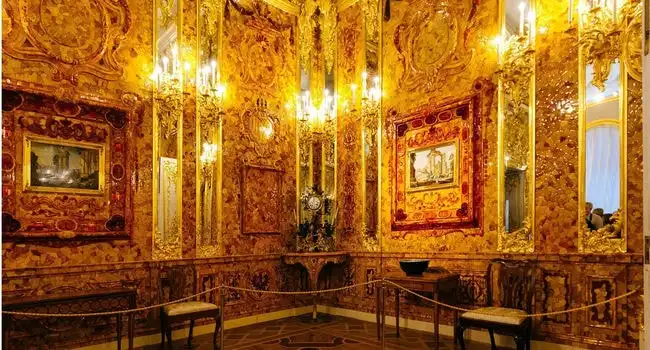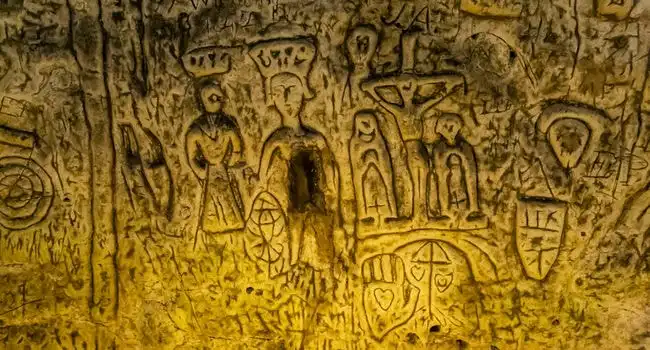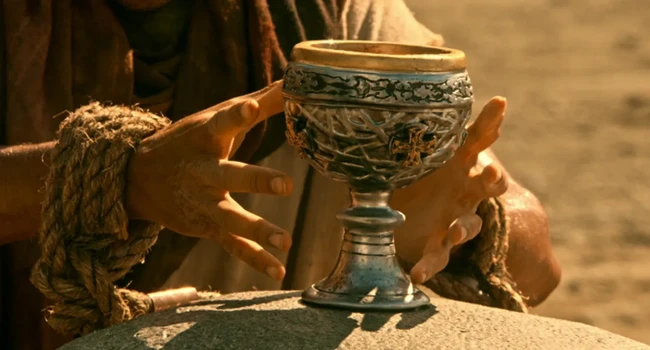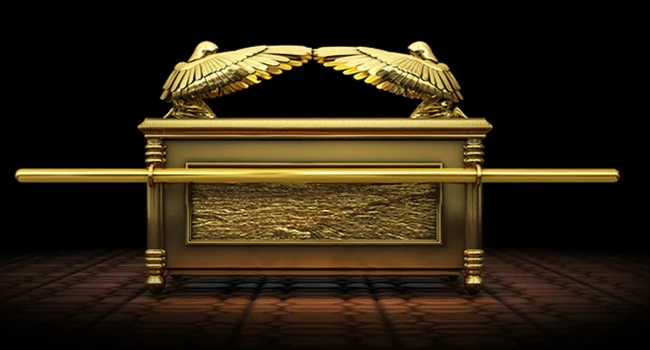Step into a world where history and mystery intertwine, as we embark on an extraordinary journey to uncover the Top 10 Lost Treasures of History. From vanished civilizations and concealed tombs to elusive religious artifacts, this list digs deep into the annals of the past to bring you closer to treasures that have captivated the human imagination for centuries. Get ready to traverse continents and timelines, as we explore these tantalizing enigmas that have eluded historians, archaeologists, and treasure hunters alike. Strap in for an adventure that promises not only glittering wealth but profound insights into humanity’s unending quest for the elusive and the divine.
10- The Amber Room

Photo Credit: BBC
Originally constructed in the 18th century, the Amber Room stands as one of history’s most enigmatic lost treasures. Crafted with intricate amber panels and gold leaf, this room once adorned the Catherine Palace in Russia. German troops looted it during World War II, after which it vanished, prompting numerous theories and expeditions. The craftsmanship alone makes this treasure incredibly valuable, but its historical and cultural relevance elevates its significance further. It’s not merely an opulent room; it’s a missing piece of Russian heritage.
By exploring the history of this lost treasure, we delve into a narrative that captures the turbulence of 20th-century geopolitics, the dark side of art preservation, and the relentless human quest for wealth and power. Numerous researchers have tried to locate the Amber Room, but their efforts have been in vain. Each failed expedition adds another layer to its already intricate history. For history enthusiasts, the tale of this lost treasure serves as a chilling reminder of the impermanence of even the most beautiful creations and the depths people will go to claim them for themselves. To this day, the Amber Room remains one of the most sought-after lost treasures in history.
9- The Florentine Diamond

Photo Credit: The Daily Beast
The Florentine Diamond, a yellow gem with a storied past, encapsulates the essence of lost treasures. Weighing approximately 137 carats, the diamond has a complex history, passing through various European courts before mysteriously disappearing. Originating from India, it became part of the Austrian and then the Tuscan Crown Jewels. Many historians speculate that it may have been sold and its identity altered to avoid recognition.
Unlike other lost treasures, the Florentine Diamond has been the subject of various legal disputes and royal tussles. Its disappearance not only signifies the loss of a valuable gem but also reflects the often tumultuous journey that such treasures undergo. Each change in ownership symbolizes a shift in power dynamics, making this diamond a compelling subject for historical scrutiny. As a historian, tracing the Florentine Diamond’s trajectory reveals insights into European power plays, the politics of possession, and the fickle nature of value. This lost treasure, like many before it, raises questions about the ethics surrounding historical artifacts and the repercussions of their loss.
8- The Sceptre of Dagobert

Photo Credit: Rehlat
The Sceptre of Dagobert, part of the French Crown Jewels, was last seen in 1795. This solid gold piece was created for Dagobert, King of the Franks, in the 7th century. It encapsulates an era of royal authority and religious symbolism. Historians and treasure seekers often cite this artifact as one of history’s truly seminal lost treasures. The scepter vanished during the upheavals of the French Revolution, a period when many treasures faced destruction or theft. Its disappearance raises intriguing questions about the fate of cultural artifacts during periods of immense societal change.
This lost treasure serves as a historical lens through which we can scrutinize the social and political machinations of Revolutionary France. Not merely a symbol of lost wealth, the scepter is a reminder of the transient nature of power and the vulnerability of cultural heritage. Numerous theories abound about its current location, each more fascinating than the last. But until it’s found, the Sceptre of Dagobert remains a missing link to a bygone era, tantalizing historians and treasure hunters alike.
7- Treasure of the Knights Templar

The legendary wealth of the Knights Templar has captivated historians and treasure hunters for centuries. Established in the 12th century, the Templars amassed a tremendous fortune, much of which vanished when the order was disbanded by Pope Clement V. Although some historians argue that the treasure was seized by the church or various monarchs, its true whereabouts remain unknown. The mystery surrounding this treasure has fueled countless quests and speculative theories, ranging from hidden vaults beneath Jerusalem to sunken ships in the Mediterranean.
The cultural and historical implications of this lost treasure are profound. The Templars were among the most powerful and secretive organizations of the medieval world, and their missing treasure raises questions about the financial structures of the time and the politics that led to the order’s downfall. It also sparks debates about the ownership and ethical considerations of seeking lost treasures that may be considered cultural heritage. For a historian, this treasure trove provides an unmatched opportunity to understand the complexities of medieval finance, politics, and religion.
6- Tomb of Genghis Khan

Photo Credit: National Geographic
Somewhere in Mongolia, concealed by centuries of history and legend, lies the tomb of Genghis Khan. The location of this tomb has remained one of the world’s most tantalizing lost treasures. Genghis Khan, the founder and first Great Khan of the Mongol Empire, ordered the site to be hidden upon his death. The mystery isn’t just about the tomb itself, but also the treasures it’s said to contain. Legend holds that his soldiers killed all who constructed the tomb to preserve its secrecy.
Historians and archaeologists have ventured into Mongolia’s rugged terrains, fueled by tales of vast wealth and artifacts, but the tomb remains elusive. When we talk about lost treasures, the tomb of Genghis Khan offers an intricate narrative that ties in geopolitics, the spread of empires, and the personal whims of one of history’s most captivating figures. Its undiscovered status raises important ethical and cultural questions. For a historian, the hunt for this lost treasure is also a journey into understanding the myths and realities that shaped a significant portion of the known world.
5- Lost Colony of Roanoke

Photo Credit: Science
Although not a tangible treasure, the Lost Colony of Roanoke presents a different kind of wealth—a historical mystery that has intrigued historians for centuries. In 1587, English settlers arrived at Roanoke Island, only to vanish without a trace by 1590, leaving behind the cryptic word “Croatoan” carved into a tree. The disappearance of the colony and the fate of its settlers have become one of America’s most enduring mysteries and thereby one of its most compelling lost treasures.
For historians, the Lost Colony serves as an intriguing case study in early colonization attempts, and its story is laden with theories ranging from assimilation with local Native American tribes to mass starvation or disease. This lost treasure is a reminder of the risks, challenges, and unknowns that early settlers faced and offers insights into the colonial mindset of the English at the time. Like all great mysteries, Roanoke’s lost colony continues to inspire explorations and debates, making it a monumental subject in the annals of lost treasures.
4- Library of Alexandria

Photo Credit: Bookstr
The Library of Alexandria, once the intellectual center of the ancient world, represents one of history’s most devastating lost treasures. Destroyed by a series of incidents, including fires and military conquests, the library contained an immeasurable wealth of knowledge in the form of scrolls and books. Its loss is considered one of the greatest cultural tragedies in history. For a historian, the Library of Alexandria is more than just a lost treasure; it’s a symbol of the fragility of collective human knowledge.
Had it survived, our understanding of ancient philosophies, sciences, and histories could be vastly different. Its destruction poses questions about the vulnerability of cultural landmarks and the irreplaceable nature of historical knowledge. The library also encapsulates broader themes of intellectual freedom, the perils of cultural imperialism, and the fragility of human creations. For these reasons, the Library of Alexandria continues to be an enduring subject of study, its absence profoundly felt across millennia.
3- Holy Grail

Photo Credit: Sporcle
The Holy Grail, often described as the cup used by Christ at the Last Supper, is perhaps one of the most famous lost treasures in human history. The quest for the Grail has been immortalized in countless tales, poems, and even modern films. Yet, its actual existence remains a subject of debate among historians and theologians. Some suggest that the Grail is not a physical object but a symbol of divine grace. Others argue that it’s a relic lost to time, waiting to be discovered.
For historians, the Holy Grail serves as a rich subject for investigating the fusion of religious myth and historical fact, a confluence that has generated countless pilgrimages, quests, and theories. This lost treasure has been co-opted into various cultural narratives, each attributing to it a particular set of mystical properties and powers. The Holy Grail stands as an emblem of humanity’s eternal quest for the divine, making it one of the most intriguing and enduring subjects in the pantheon of lost treasures
2- Burning of Nalanda

Photo Credit: BBC
The loss of the ancient university of Nalanda, specifically its three great libraries, ranks as one of the most catastrophic events in recorded history. Located in modern-day Bihar, India, Nalanda was a center for learning and a repository of thousands of manuscripts, covering subjects as diverse as grammar, logic, literature, astrology, and medicine. In 1193, the university was ransacked by the Turkic invader Bakhtiyar Khilji. The libraries, described as extensive complexes, burned for several months, erasing invaluable records of human thought and achievement. For historians, the destruction of Nalanda’s libraries is more than a story of lost treasure; it represents the irrevocable loss of collective wisdom and cultural heritage.
The fact that the libraries burned for months underscores the enormous volume of scholarly material that was lost—texts that had the potential to reshape our understanding of ancient civilization. Like other lost treasures, the burning of Nalanda raises painful questions about cultural vulnerability in the face of military conquest. Yet, it also serves as a potent reminder for current and future generations about the significance of preserving knowledge and history. As one of the most devastating incidents of cultural vandalism, the burning of Nalanda’s libraries holds a haunting space in the realm of lost treasures.
1- Ark of the Covenant

Photo Credit: News.com.au
Regarded as one of the most sacred lost treasures, the Ark of the Covenant has fascinated historians, archaeologists, and adventurers for centuries. Described in the Hebrew Bible as a gold-covered wooden chest containing the Ten Commandments, the Ark was central to ancient Jewish worship. It was last reported to be in Solomon’s Temple in Jerusalem before the Babylonian conquest, after which it disappeared from historical records. The Ark of the Covenant is not just a religious artifact; it’s a symbol deeply embedded in the Judeo-Christian tradition and a tantalizing mystery for historians.
Its disappearance has led to various theories and expeditions, some practical and others bordering on the fantastical. For a historian, the Ark serves as an intersection of faith, history, and legend. Its enduring allure lies in the myriad questions it poses—about the line between myth and history, the responsibilities surrounding sacred relics, and the lengths to which people will go to claim or recover lost treasures. The Ark continues to capture imaginations, serving as a poignant reminder of the indelible links between our present and our shared, yet elusive, past.


